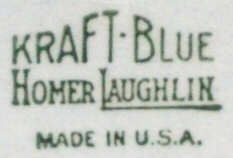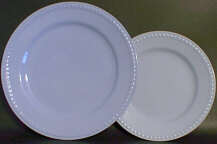 In the 1930s, several potteries were producing wares in solid color clays. These pieces would then receive a clear glaze and the colored body would show through. The Crooksville China Co. and the Taylor, Smith & Taylor Co. both used pink bodied ware for a number of years before Homer Laughlin attempted such a line. However, HLC would initially take a different direction producing blue body ware instead of pink. In the 1930s, several potteries were producing wares in solid color clays. These pieces would then receive a clear glaze and the colored body would show through. The Crooksville China Co. and the Taylor, Smith & Taylor Co. both used pink bodied ware for a number of years before Homer Laughlin attempted such a line. However, HLC would initially take a different direction producing blue body ware instead of pink.
In the first few months of 1937, HLC considered producing already existing shapes with blue bodies. By July, it was decided a new line would be created with a thick embossed rope border and the first few pieces were modeled: sugar with cover, teapot with cover, and the creamer. The new line would be unlike colored bodies produced by other potteries in that the applied handles and finials were made in a white clay producing contrasting colors with hollowware.
 Once the sugar, creamer, and teapot were approved, the rest of the Kraft Blue shapes were modeled. There are several notes in Frederick Rhead's journals that indicate these shapes, especially the creamer and teapot, were copies of German products sold by Woolworth's. From August to September 1937, the plates, platters, and bowls were created. Two other shapes were made at this time; a handle(white body) to be applied to Willow teacups(blue body) and a double egg cup. Once the sugar, creamer, and teapot were approved, the rest of the Kraft Blue shapes were modeled. There are several notes in Frederick Rhead's journals that indicate these shapes, especially the creamer and teapot, were copies of German products sold by Woolworth's. From August to September 1937, the plates, platters, and bowls were created. Two other shapes were made at this time; a handle(white body) to be applied to Willow teacups(blue body) and a double egg cup.
On September 15, 1937, several names were considered for the new line including:
- Blue Rope
- Cadet
- Blue Body
- Lyric
- Chalet
- Blue Danube
- Iris
Finally, on September 30th, the new line was called Kraft Blue, and on October 25, 1937, it was officially released into production. There are some pieces of Kraft Blue that can be found with a general HLC backstamp, but most will have the special Kraft Blue mark.
Two more items were added to Kraft Blue in April 1938: 10 1/4" dinner plate and a cream soup cup. Like other hollowware, the cream soup cup has a blue body and white handles. On January 27, 1939, Rhead notes working on a "small ball jug, blue jug with white handle" This piece was based on the Harlequin novelty creamer. The Harlequin rings were removed and a new rope handle was made. This handle had to be made separate from the body so it could be produced in the contrasting white. This early rope handle was not put into production and on May 29, 1939, a new style was being considered. The handle would be plain and an embossed rope would appear on the neck of the body. This was ultimately rejected and finally, at the end of June 1939, the jug with a plain blue body and plain white handle was created. This is the style collectors will find today, though at least one Kraft Blue example has been found with Harlequin rings.

Novelty creamers, left to right: Harlequin, Kraft Blue with Harlequin rings, standard Kraft Blue.
An oatmeal was made in 1941 and released into production in April of that year. It was the last piece added to the line. Why this line wasn't expanded with a casserole, sauceboat, and other hollowware forms isn't clear. It started out as a line for Woolworth's, but other retailer would carry the line - plain and later with decals. On April 5, 1941, Rhead notes making samples of "Pink Kraft plates and teas for Woolworth's." Kraft Pink was approved and put into production shortly thereafter. Now Homer Laughlin was producing a pink bodied ware that others had been making for years. The assortment for Kraft Pink is identical to Kraft Blue, though don't expect pink to be as easy to find. Kraft Pink novelty creamers are scarce followed by the teapot and cream soup cups.
Kraft Pink and Kraft Blue were made until the mid-1950s. A second line, Skytone, also used the blue body clay. Based on the Jubilee shape, it began production in the summer of 1950. There are some instances where sets of Skytone are found with pieces of Kraft Blue and vice versa. Skytone's shapes are very distinct from Kraft Blue so there should be no confusing the two. Both lines were almost always marked appropriately, however, every once in a while a piece will turn up with the wrong backstamp. A Kraft Blue novelty creamer was found with a Skytone marking. Also a Skytone demitasse cup and saucer was found with a Kraft Blue marking.
See also section on Skytone & Suntone.
|